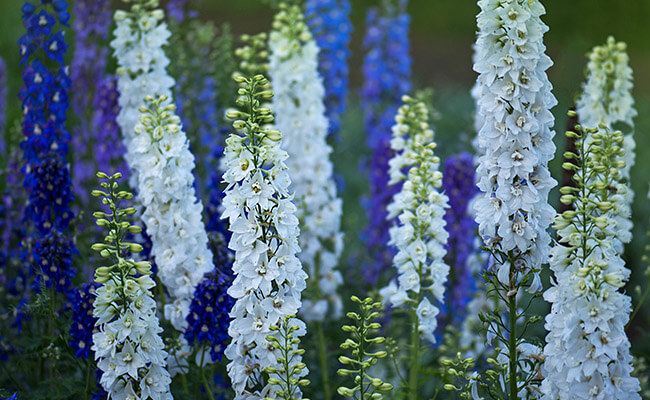Everything You Need To Know To Grow Larkspur Flowers Plant
Sitting in your own garden as the evening sun is going down the horizon, surrounded by beautiful flowers, sounds soothing! The images we just painted are a simple evening for a gardening enthusiast who loves having his/her own small garden.

When we talk about a garden full of pretty flowers, it is impossible to leave Larkspur flowers out of the list. These magnificent blossoms are too precious to not have, and with the right amount of care, growing Delphiniums is seriously a piece of cake.
If you're someone who loves the appeasing art of gardening and enjoys the solitude that gorgeous flowers provide, then here is everything you need to know about the blushing blue blossoms.
Larkspur Flowers- An Introduction
Before we get into all the information you need to know on "How to Grow Larkspur Flower", why not get to know the vibrant blooms a little?! These sweet buds belong to the herbaceous plants and are mainly native to the tropical hills of Africa and all of Northern Hampshire. The charming flowers are lookers for sure but beware as they are highly toxic if consumed by humans; therefore, it is better if you keep kids away from them.

Lastly, these beauties are the birth flowers of quirky July borns, so if you wanna give them away as gifts, you can easily buy a flowering plant online.
How to Grow
As the introduction is out of the way now, let us take you through the process of growing these charming blossoms. Basically, there are two ways to get these mesmerizing flowers into your garden, namely-

Germination - In easy words, germination is when the seed starts growing into a plant. We will be honest with you, germination of Larkspur is not an easy task, and it is pretty challenging to stimulate the exact environment it needs. Still, if you wish to try, The seeds need an initial cold environment; hence it's best to keep them in the deep fridge for at least two weeks. Put the seeds in an airtight ziplock bag along with some perlite. Remember to keep the temperature below 18 degrees celsius, and after two weeks, plant the seed usually.
Plantation - Planting is what we recommend for you if you need the graceful Larkspur in your garden. The process is actually pretty standard. You buy a small growing plant and harvest it into your garden. However, you must make sure that the plant is in direct sunlight as the flowers love it. But you have to make sure that the soil is always a little damp as the plant needs a lot of water. Lastly, you gotta make sure that there is a proper drainage system as the root can root. This may sound like a lot, but the main thing is to just check on the plant and water it as required.
Common Tips and Tricks

Now, after you have successfully planted the alluring flower, it is time to maintain it. To help you out with the same, here are some tips you can follow:
- The larkspur plant can grow quite tall and need support to remain upright. Lightly tie the stem of the plant with a bamboo stick to make that happen.
- Use a liquid fertilizer every two to three months, based on the requirement of the plant, as the plant enjoys being in highly rich and fertile soil.
- Not a lot of people know this, but Larkspur can self-seed as well. So it would be wise to leave some space beside the plant.
- Keep on spraying the plant and soil it with water as it enjoys humidity.
- Prune the plant regularly, and at the end of the season, when the flowers turn brown, it's better to cut them to make space for the new ones.
Basic Problems:
One of the main problems with Larkspur, just like most plants, is the issue of parasites. Slugs and snails are commonly attracted to this gorgeous plant. You must get it treated as soon as possible, and if it's too late, then it is better to remove the plant altogether to save the others.
The next issue is the fungal infection that Larkspur is prone to, and sometimes it is also impacted by mildew as well. You must keep an eye out for that and must get it treated immediately.
Lastly, use a regular, organic bug repellent to keep the harmful insects out of the plant.
Blooming blossoms are nature's best therapy; the moment one glances at them, they make you smile. Getting these wonderous blooms may require a little effort, but the outcome is always rewarding; happy gardening!















